|
|
||
|
They may have been failures, beset by naivety, contradictions and political opposition, but revisiting the experimental structures of the 1960s and 70s is more than just architectural navel-gazing, argues Douglas Murphy in his latest book. Peter Maxwell explains Architecture, alternately held up either as the cause of or solution to so many societal ills, coupled with the naturally projective nature of the endeavour, is often at the centre of any serious attempt at foresight. The discipline has certainly formed its own eddy within the current leftist zeitgeist for future-fraught publishing, a retort to the key shibboleth of our post-crash era: “There is no alternative.” This phenomenon, which has seen a much-needed repoliticisation of architecture criticism, arguably began with critic Owen Hatherley’s first book, 2009’s Militant Modernism, an acerbic unravelling of 20th-century utopianism. The latest addition is Last Futures, a text by Icon’s resident architecture correspondent Douglas Murphy. Murphy’s debut was 2012’s Architecture of Failure, which dealt with the discipline’s difficultly in negotiating the futures both promised and occluded by the filigree architecture of the Crystal Palace, cycling forward to the mid-century avant gardes and on into digi-space. His new text covers much of the same chronological ground, again starting with the Great Exhibition and its progeny, though within that frame its scope of enquiry is far wider, fleshing out a history of what Murphy coined in the earlier book as “solutionist” architecture. Solutionism is exemplified by the work of “naïve” optimists such as Buckminster Fuller and Archigram, an admixture of sci-fi, mysticism and advanced engineering that promised to avert many impending global catastrophes … if only the polity could be convinced to adopt it wholesale. Murphy was hard on these idealists in 2012, and he reasserts in 2015 that he remains “largely anti-utopian”, but Last Futures is in fact much more magnanimous to the fantasies of those 1960s and 70s experimenters. The book is a retelling and reparatory contextualisation of the work of the likes of Fuller, Peter Cook, Cedric Price et al., as well as an analysis of why their egalitarian “grand visions” eventually soured in the anxiety-charged atmosphere of the 70s and beyond, a period beset by financial, military and ecological crises. Murphy’s book works as a selective architectural history of the 20th century, navigating past the formalist mulch and theoretical drift preferred by much of the architectural establishment. Instead it focuses on the shaper (if in this case perennially stunted) branches of the discipline’s evolutionary tree, the worthy but often impractical dreams of architects who dared to treat their work as a potential panacea. Starting with expo-tecture, it proceeds through post-war mass-housing models, campus design, techno-urbanism, eco-communes and space stations, joining the thematic dots between developments that, 50 years on, remain the highpoint of architectural aspiration. Behind the ziggurats, bio domes, gantries and envelopes that the architects proselytised – if rarely built – was a genuine desire to elevate and unburden the user; a well-meaning, misguided attempt at stewardship. In the cases where the projects did break ground, the scale of their architects’ ambitions was often in direct proportion to the speed with which they were cauterised, as vested interests suffered a failure of nerve when it proved that this more spatially democratic architecture might – surprise – serve to undermine their own position (step forward the rectors of Britain’s post-war New Universities). Many of the new building technologies and processes pioneered during this period of architectural imagineering were eventually co-opted for more mundane, profit-driven motives. Elements of the megastructure projects championed by the avant gardes of 60s aren’t, in fact, uncommon today, but they persist only in the big sheds and automated distribution networks of global capital rather than the envisioned plastic urbanism of the Plug-In City. Indeed, Murphy’s arguments all return to the crosshatched shadow of Joseph Paxton’s Crystal Palace – the birthplace of a mass consumer consciousness – as it is rehearsed ad infinitum in Fuller’s Expo67 dome, Constant Nieuwenhuys’s New Babylon, Price’s Fun Palace and Archizoom’s No-Stop City. As Murphy relates, via philosophers such as Peter Sloterdijk and Walter Benjamin, the Palace is a functional “metaphor for the global world interior” created by capitalism. But in its internal contradictions of control and emancipation, its ability to either harmonise or subvert our relationships to technology and nature, it also offered potential blueprints on how to supersede the current paradigm, as many of the projects Murphy enumerates failingly grasped at. As the same crises that galvanised that cohort continue to beset our own generation, we might endeavour to find something hopeful lost in the wreckage of their failures, even if it will likely not be the cure-all we were once promised. Simply the courage, perhaps, to believe in alternatives? That might be enough. |
Words Peter Maxwell |
|
|
||


















